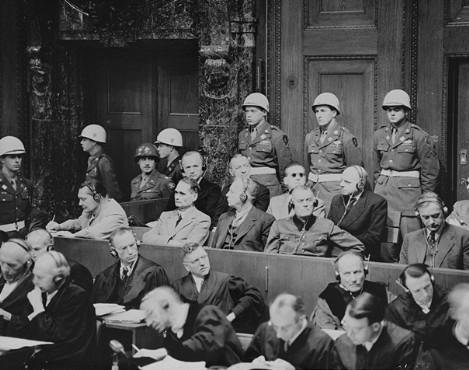Be sure to check the article index page for this column to read other parts of this article.
Last article I began talking about the Nuremburg trials and it’s relationship to pathocrats and psychopathy.
I ended with : “But there was a time when political psychopaths – pathocrats, to be more precise, because in a pathological system more than one type of pathology participates in the network of control – could be studied up close and personal, and they were. However, the pathocrats running the prison, who made this opportunity a reality, quickly squashed any future possibility of gaining the much-needed data that could be gleaned from their captives. I am referring to that time right after the Allies won World War II, and a representative selection of Hitler’s top officials were held to be tried for war crimes and crimes against humanity at the International Military Tribunal in Nuremburg which we will dive into in the next article.”
The most wicked of the accused were executed in short order. While many saw this as justice, future generations were robbed of what could have been a treasure trove of knowledge about the true nature of Nazism and its leading figures. Luckily, while the defendants were still living, a few American psychologists were able to glean what they could, and one of them – Nuremberg prison psychologist Gustav M. Gilbert – even wrote a book, The Psychology of Dictatorship which could have been the foundation of a new science.
But that is not what happened. Not only were the most interesting of the criminals summarily executed, the book about them was never reprinted and only the most dubious of its data (the Rorschach protocols Gilbert conducted) has been looked at and talked about since.
It’s hardly coincidental that the bulk of his conclusions were ignored and only the weakest parts promoted (in Miale & Selzer’s The Nuremburg Mind, for example). It’s classic perception management. Those reading references to Gilbert’s work, which reach valid conclusions though using dubious proofs (the Rorschach test is all but completely discredited in today’s fields of experimental psychology and psychiatry, especially when it comes to psychopathy), will unfairly conclude that there is little value in his work. Ironically, Gilbert hardly mentions his Rorshach tests in the book, and yet this is where ALL attention has been focused when anyone talks or writes about the psychology of the Nuremberg war criminals. So, what did Gilbert really say?
His book was published in 1950, nine years after Hervey Cleckley’s The Mask of Sanity first hit the shelves in 1941. At the time, it was common among historians and other academics to downplay the role of individuals in the shaping of history. As one textbook of the time stated: “With some striking exceptions, the individual counts for little in the social scheme of things… [A leader’s] success will depend mainly on his happening to lead them [social circumstances] in the direction in which they happen to be going.”1 As if social circumstances were some nebulous force completely divorced of human motivations! Unfortunately, this is still the prevailing view among historians. Today it’s called “structuralism” – Hitler wasn’t the problem per se, the whole Nazi structure was.
This is certainly partially correct, but thanks to a convenient twist in the theory, it poses no problems to psychopaths (which is probably why it’s so popular these days). If the role of the individual is downplayed, it’s all in the structural, economic, social forces, you see! (Never mind that psychopaths and other pathologicals have inter-penetrated the social structure with a ramified network of mutual pathological conspiracies and are busily causing those very problems!) But with these assumptions guiding the historian’s hand, any relevant characteristics of the individuals comprising that structure, and giving it force and meaning, are equally dismissed offhand. Thus, any patterns to be noticed in the nodal points of key positions of power fade into the background. By downplaying the features of the single individual (e.g. Hitler), the theory is willfully blind to the results caused by a network of similar-minded (but not normal) individuals (i.e. the psychopaths within the whole Nazi network: the SS, lawyers, bankers, businessmen, military men, etc.).
If only there weren’t those darned anomalies!
According to the theory, Hitler was an anomaly of the system. A man whose interests just happened to correspond to the nature of the “structural” forces at play. But despite their popularity, these theories cannot account for the strikingly foreign nature of the times they seek to study and explain. In the minds of many, Hitler’s Germany was one of those “exceptions”. The brutal and anti-human nature of the Nazi regime – the “new reality” to which the Germans and their victims were subjected – became clear to the world over the course of the war, and it horrified humanity. As Field Marshal and Nuremberg defendant Wilhelm Keitel related to Gilbert, “He [Hitler] stood for a complete reversal of [the Wermacht’s] values: brutality and injustice became virtues of ‘hardness’; decency and honor became contemptible weakness.”2 When Gilbert asked Rudolf Höss, commandant at Auschwitz, if he had ever considered whether his millions of victims deserved their fate, “he tried patiently to explain that there was something unrealistic about such questions, because he had been living in an entirely different world.”3 In this world, the leaders possessed the qualities of “uncompromising hardness and brutality, nationalism with a paranoid tinge, in-group loyalty and out-group hostility. Deceit, treachery, persecution, and murder could be condoned in this militant, ethnocentric frame of reference, and the leader was the one who excelled in these virtues.”4
As Gilbert later wrote, the post-war trials led to “widespread speculation concerning the sanity or lack of it on the part of the whole Nazi leadership”.5 This speculation on the part of the public was simple common sense, because one can’t hope to understand a system like Nazism without a good understanding of individual AND social psychology. The Germans were experiencing the full force and iron grip of a macrosocial psychopathic reality.
Predictably, academic opinions quickly polarized between two, extreme and equally untenable conclusions. Either the Nazis (as a whole, mind you) were totally psychotic (think Norman Bates’ character in Psycho) or normal people “just following orders”. This cognitive error (also taken straight out of the psychopath’s handbook) is still prevalent today. And as usual, the truth is not quite so simple; the competing options are not mutually exclusive. As historian of ideas José Brunner notes, “one can notice a surprisingly broad area of underlying agreement” between the opposing opinions of Nazi leaders as “sane or psychopaths”.6 In Gilbert’s work (and later, Lobaczewski’s), an understanding of psychopathy, psychopathology in general, and normal social influences helped place the discussion in a more realistic and empirical middle ground. “Anomalies” like Nazism involve a complex network of psychopathic individuals who inspire the system as a whole, individuals with various other mental pathologies, and normal people who get caught up under their collective spellbinding influence. While leaders can and do play a crucial role in history, Gilbert writes:
… that does not imply by any means that leaders create history single-handedly. … socioeconomic, political, and historical forces … do not exist as pure abstractions, but become manifest only through the behavior of human beings… [the] interplay of personalities and social processes… cultural mores help to determine the nature of political leadership, and the latter in turn influences the development of the cultural pattern.7

© USHMM Photo Archives
The defendants listen as the prosecution begins introducing documents at the International Military Tribunal trial of war criminals at Nuremberg.
We will discuss more about Gilbert in our next article. Stay tuned!
Notes:
- Quoted in Gustav Gilbert’s The Psychology of Dictatorship (New York: Ronald, 1950), 298.
- Ibid., 220.
- Ibid., 255.
- Ibid., 294.
- Quoted in Miale & Selzer’s The Nuremburg Mind: The Psychology of the Nazi Leaders (New York: New York Times Book Co., 1975), xi.
- Jose Brunner, “Oh Those Crazy Cards Again”: A History of the Debate on the Nazi Rorschachs,1946 – 2001,” Political Psychology 22(2), 2001, 237.
- Gilbert, op cit., 303, 4, 5, 7.






